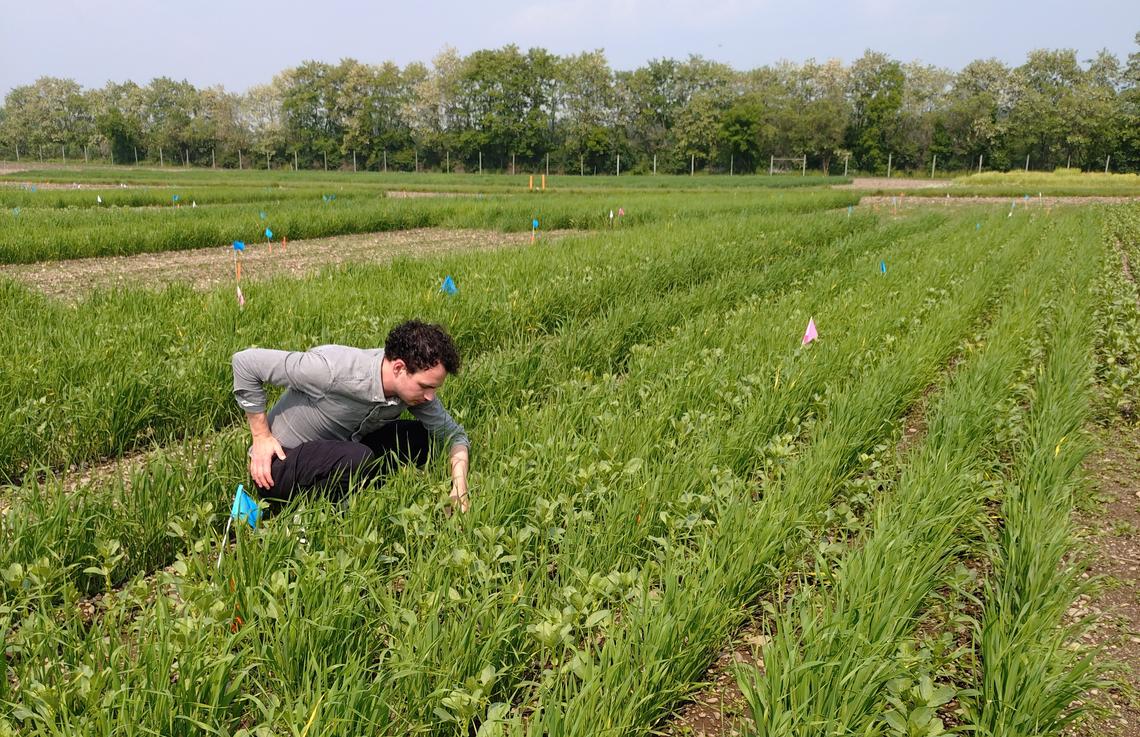EWRS Travel Grant Report – David Kottelenberg
Posted on June 10th, 2025 on 10:56:56 by Aleksandra Savić

The third of the awardees 2024 of the EWRS travel grants for bi-lateral cooperation reports on his experience

Home institution: Centre for Crop Systems Analysis, Wageningen University, The Netherlands
Mentor (home institution): Niels Anten
Host institution: Soil and Crop Sciences, Cornell University, United States
Mentor (host institution): Matt Ryan
Dates of exchange: 12 May – 6 June 2025
Project title: The effect of weed functional traits on cereal-legume intercrop performance and weed suppression
Study Visit Overview
From 12 May to 6 June 2025, I had the opportunity to visit the Soil and Crop Sciences group at Cornell University, in Ithaca, NY, USA. I was kindly received by everyone in the group, and I am especially grateful for the warm welcome from Natasha Djuric, with whom I am collaborating on a project supported by the EWRS bi-lateral cooperation grant.
During my stay, I engaged with many researchers in weed science and agroecology, exchanging ideas and exploring potential avenues for future collaboration. In the first week, I gave an introductory presentation on my research into weed suppression in cereal-legume intercropping systems. In the third week, I gave a second, more specialized presentation on crop modeling to a smaller group of researchers with a focus on modeling approaches.
In addition to these academic exchanges, I actively participated in a collaborative field experiment. This ongoing trial includes sole crops and row intercrops of barley and faba bean, with weed-infested, herbicide-treated, and weed-only subplots. The objective is to investigate how the various cropping systems and environments affect weed community composition. The data from this experiment will contribute to the development of a crop model aimed at quantifying the influence of weed functional traits on crop system weed suppressiveness. Ultimately, we aim to explore whether intercrop designs can foster more “neutral” weed communities.
My visit to Cornell University was a very rewarding experience. It provided valuable insights for our current project, inspired ideas for future research, and expanded my professional network. I am sincerely thankful to the EWRS and the Soil and Crop Sciences group, and particularly to Natasha Djuric and Matt Ryan, for making this opportunity possible.
Project Background and Motivation
Conventional weed management heavily relies on herbicides, which can degrade soil health, harm biodiversity, and accelerate herbicide resistance. Cereal-legume intercropping presents a promising alternative by enhancing weed suppression through ecological mechanisms. However, not all weeds negatively affect crops, and diverse weed communities can contribute to agroecosystem resilience. The interplay between cropping system design and weed functional traits remains poorly understood.
To address this, our project combines field experimentation with functional-structural plant (FSP) modelling — a dynamic, 3D simulation approach that captures plant growth and trait interactions in space and time. This approach helps us better understand and optimize weed suppression in intercropping systems through the lens of functional traits.
Project Objectives
- Quantify weed suppression, canopy cover, light interception, and trait adaptivity in barley (Hordeum vulgare), faba bean (Vicia faba), and their 1:1 row intercrop.
- Explore how weed community composition responds to these cropping systems based on weed functional traits.
The field experiment includes weed-infested, weed-free, and weed-only subplots. We are collecting data on biomass, light interception, canopy structure, and crop morphology. The FSP model we are developing simulates cereal-legume growth and includes weed functional types based on field observations, allowing us to analyse interactions and support agroecological design.
Scientific Achievements
The research is ongoing, with fieldwork currently underway. Preliminary findings at 32–38 days after sowing show that barley sole crops capture more light and provide more canopy cover than faba bean, while intercrops resemble barley in both metrics. This suggests barley’s competitive dominance and supports the hypothesis that weed biomass in intercrops will be similar to barley sole crops, with weeds functionally similar to barley being more suppressed.
Development of the FSP model is also in progress. Once complete, it will allow us to simulate crop–weed interactions across different cropping systems and explore design strategies that balance yield, biodiversity, and weed suppression. The results of this work will contribute to a forthcoming publication currently being prepared for Weed Research.
Personal Contribution and Skills Gained
Throughout the exchange, I was actively involved in both field and modeling components of the project. I contributed to the design and implementation of the field experiment, participated in data collection and initial analysis, and am leading the development of the FSP model, which captures detailed plant architecture and simulates crop–weed dynamics in intercrops.
This exchange significantly strengthened my skills in field-based weed ecology, modeling approaches, and interdisciplinary research. It also enabled me to establish valuable professional connections. I will serve as co-first author on the upcoming scientific publication resulting from this collaboration.
606 x viewed | 7 Likes -
Message to the author
Filter by theme
Filter by Working Group
How can I submit a post?
We would like to welcome you as a contributing author for the EWRS blog. Please contact the Communication Officer, Camilla Moonen. She can give you writing access to the blog. After that, you can start writing articles for the blog, from the 'My Account page'. More information can be found on the "How to use the Blog page".
